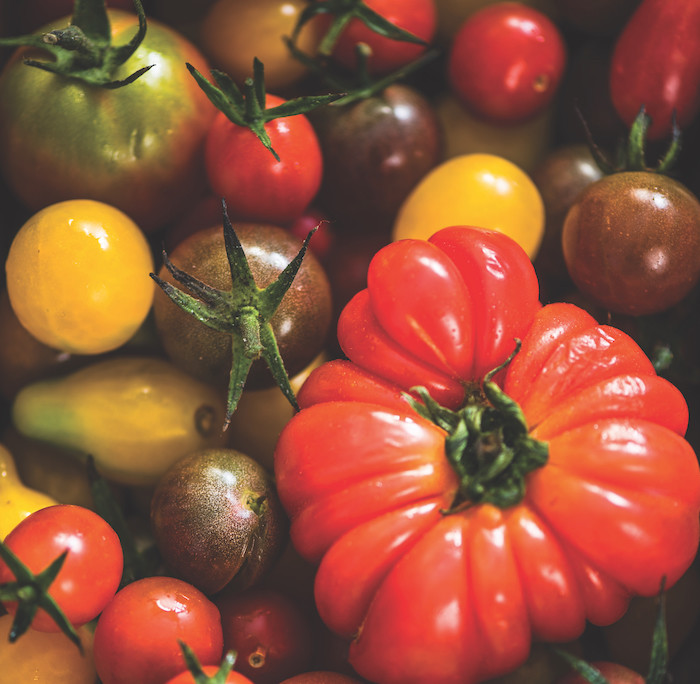
Tomatoes and the plants they come from have all manner of uses in cocktails, as Anistatia Miller and Jared Brown recount.
Tomato season is well underway in the garden, but you have to be ready because it always seems to go out with a harvest bang.
It is a bittersweet abundance as we know that once these are gone, gorgeous ripe tomatoes will also disappear from the shops until next season, replaced with flavourless marvels of agricultural engineering bred to survive repeated falls from store shelves to the floor without bruising. So, when the bounty comes, we can’t resist getting our fill and preserving a last taste of summer.
Tomato water had a heyday in the early 2000s when it seemed requisite for attaining a Michelin star. Everyone who was anyone served it. It is remarkably versatile behind the bar. From the obvious – making clear Bloody Marys – to sparkling drinks, molecular cocktails (a pairing that likely occurred simply because tomato water and agar agar and other jell kits hit the trade headlines simultaneously) and even as dilution for Martinis. With the rise of non-alcoholic cocktails, there is yet another reason to revisit this garden-fresh liquid.
There are a few methods for extracting tomato water. If you happen to have a centrifuge, you’re all set and you’ve likely already played around with extracting the colour from tomato juice. But a high-tech kit is unnecessary. Chop a kilo of ripe tomatoes, add a sprinkling of salt and wrap them in cheesecloth. Tie the bundle and suspend it with a wooden spoon above a pot through the knot. Set this in the fridge overnight to let the juice drain into the pot. You can also run tomatoes through a vegetable juicer, then simmer the resulting pulp for about 10 minutes. The solids will separate from the water and can be strained with a chinois or a cheesecloth. Then you are ready to start mixing.
Tomato water can be preserved by freezing it into cubes. This makes it very handy for use as well. Another way to preserve it is to make a tomato-water cordial or liqueur. It is an unusual fl avour, but it works well in Gimlets and is phenomenal in a Gin Basil Smash (tomato water cubes also raise a GBS to another level).
Exceptional leaves
Tomatoes might not be the easiest fruit to grow in the UK, especially this summer. We often finish the season with far more green tomatoes than ripe ones (green tomato and juniper ketchup is a story for another day). However, tomato plants grow beautifully here and the leaves are exceptional as garnish. They contain trace amounts of tomatine and solanine, making them a poor choice for overindulgence. But you would have to consume an enormous quantity of them and eat them as a steady diet to be at risk. Green tomatoes contain similar levels and are a delicacy in the American South.
While the taste of the leaves is truly amazing in salads and tomato leaf pesto, as a drink garnish it is all about the aroma they bring – with no risk of toxicity. Try tomato leaves as a garnish for a Bloody Mary or Red Snapper. Spank a tomato leaf and run it around the rim of a Martini. Another gorgeous garnish you can make – if you have a dehydrator – is crisp dried tomato slices (57°C for 12 hours works for us). We add a little salt and sugar on the slices before drying them. You can take this much further with other flavours traditionally associated with tomato, from oregano to curry powder.
Here's a bit of history for you. The Bloody Mary has a portion of its roots in 19th century San Francisco, where an appetiser called the Oyster Cocktail was popular. Incidentally, we credit the Bloody Mary to the McIlhenny Company of Avery Island, Louisiana – maker of Tabasco Sauce. It launched in 1868. When the Tabasco company decided, in 1872, that it was time to reach for broader horizons, it hired marketing folks who shipped its product to New York with a recipe of tomato juice, salt, pepper, lemon juice, Worcestershire sauce, horseradish, salt, pepper, Tabasco and four or five oysters. T
here was no alcohol, but the recipe reached as far as London that year. The instruction was to eat the oysters, then drink the rest “as a cocktail”. However, a misprint stopped the drink from catching on at that time as no one was interested in a drink made with “tobacco sauce”. Naturally, the more famous portion of the story is seated in the drink made of equal parts French tomato juice and vodka by Ferdinand “Pete” Petiot at The New York Bar on Cinq Rue Danou in Paris. But that’s another story for another day. In the meantime, enjoy the best fruit of the mid-to-late summer – tomatoes.


